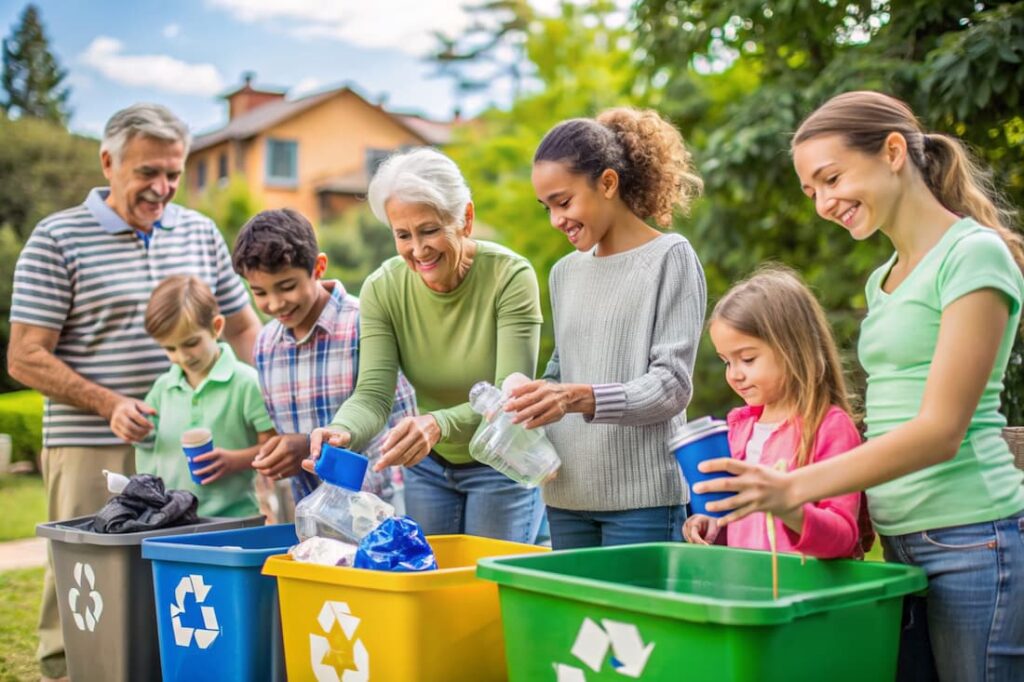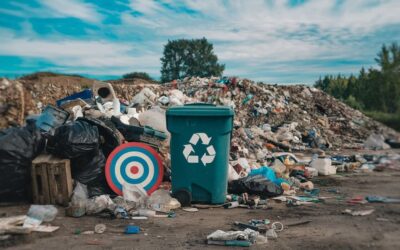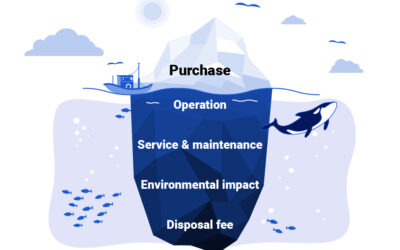In an era where sustainability is more than a mere buzzword, and embracing the principles of “reduce, reuse, recycle” can significantly impact our environment.
These practices form the backbone of effective waste management and a sustainable lifestyle, helping to alleviate the strain on our planet’s resources and fostering a healthier ecosystem for future generations.
Understanding the essence of recycling and waste management highlights the vital role individuals play in promoting eco-friendliness.
This guide covers essential strategies for reducing waste by cutting consumption, reusing materials to extend their lifecycle, and recycling to convert waste into useful resources.
By adopting these habits and understanding the recycling process, including symbols and the waste hierarchy, individuals can contribute to a broader movement towards a sustainable future, supporting biodegradable and recycled materials.
Understanding the Importance of ‘Reduce, Reuse, Recycle’
Environmental Benefits
Reducing waste not only saves natural resources but also mitigates harmful impacts on the environment. By not creating waste in the first place, you help reduce greenhouse gas emissions which contribute to climate change. Reusing items extends their life, preventing further resource consumption and waste production. Recycling, while not the first line of defence, plays a crucial role in converting waste back into useful materials, reducing the need for new raw materials and saving energy.
Historical Context of the 3Rs
The concept of Reduce, Reuse, Recycle has been integral to conservation efforts for decades. Originating from the need to conserve resources during World War II, the practice gained modern prominence with the environmental movements of the 1970s, following the establishment of the first Earth Day and the Resource Recovery Act which aimed to shift attention towards recycling and resource recovery.
Modern-day Relevance
Today, the 3Rs are more relevant than ever as we face critical environmental challenges. The principles of reducing, reusing, and recycling are essential for sustaining a circular economy, which not only supports environmental sustainability but also bolsters economic growth by creating jobs and reducing expenses related to material consumption. Engaging in these practices allows for a significant reduction in waste, conserving resources for future generations and reducing the ecological footprint of human activities.
Reduce: Cutting Down on Waste
Practical Tips for Reducing Waste
To effectively cut down on waste, consider implementing strategies such as using both sides of paper to halve paper consumption, investing in well-labelled recycling bins to improve waste sorting, and encouraging the use of reusable cups and mugs. Additionally, offices can reduce waste by avoiding unnecessary printing and using electronic formats for note-taking. Implementing a composting strategy for organic waste like tea bags and food scraps can also significantly reduce waste headed for landfill.

Impact on Natural Resources
Reducing waste is crucial for conserving natural resources and supporting sustainable development. By minimising waste generation, we not only conserve materials but also reduce environmental pollution and enhance economic efficiency. Effective waste reduction helps in saving resources by decreasing the need for new materials, thus lessening the strain on natural resources and promoting a more sustainable future.
Case Studies of Successful Reduction Efforts
Sharjah’s waste management initiative aimed for 100% landfill diversion by 2015, showcasing a commitment to innovative waste reduction strategies. Similarly, the Sicilian municipality of Calatafimi Segesta achieved an 85% separate collection rate, demonstrating the effectiveness of localised zero waste strategies. These examples highlight the importance of community involvement and innovative policies in successful waste reduction efforts.
Reuse: Giving Items a Second Life
Ideas for Reusing Everyday Items
You can significantly cut costs and reduce waste by reusing materials and equipment either within your own business or by allowing other organisations to use your unwanted resources. Office environments, for instance, can benefit from simple changes such as refilling toner cartridges, using scrap paper for notes, and opting for reusable kitchenware. Manufacturing sectors might find value in reusing packaging materials or by-products from production. Furthermore, online waste exchanges and auctions are excellent platforms for trading or selling used industrial materials and equipment, potentially generating additional income.
Benefits of Reusing
Reusing items not only prevents the accumulation of waste in landfills but also supports community and social programs by redistributing valuable resources to those in need. It is a critical component of the waste reduction hierarchy, which prioritises reducing, reusing, and then recycling. By choosing to reuse, you are engaging in an environmentally preferred option that conserves natural resources, saves energy, and reduces pollution. Additionally, businesses can gain tax benefits and reduce disposal fees by donating items that are no longer needed.
Community Initiatives for Reuse
Many communities have embraced the concept of reuse by establishing programs that support local social initiatives and provide essential items to disadvantaged populations. These programs often include job training and support for at-risk youth, enhancing both material and educational wellbeing. Reuse centres not only offer a way to obtain necessary items at a lower cost but also foster a sense of community and cooperation that can lead to sustainable urban development and increased social equity.
Recycle: Transforming Waste into New Resources
How Recycling Works
Recycling involves several key stages to transform waste into new resources. Initially, waste materials are collected and sorted into different categories. Advanced technologies such as optical sorters and eddy currents are utilised to efficiently segregate materials, ensuring that only suitable items proceed to the next stages of recycling. The sorted materials are then cleaned to remove impurities, which is crucial for maintaining the quality of the recycled products. Finally, these materials are reprocessed into new forms, such as pellets for plastics, which can be used to manufacture new products.

What Can Be Recycled?
A wide range of materials can be recycled, including plastics, metals, glass, paper, and cardboard. Specific items like plastic bottles, aluminium cans, glass jars, and newspaper are commonly accepted in recycling programs. However, it is vital to avoid contamination by ensuring these items are clean and free from food residue or other non-recyclable materials before they are placed in recycling bins. Awareness and proper sorting at the source significantly enhance the effectiveness of recycling processes.
Overcoming Challenges in Recycling
The recycling industry faces several challenges, such as contamination from non-recyclable materials and the economic feasibility of recycling certain materials. Contaminants like food waste and plastic bags can significantly reduce the quality of recycled products, necessitating more virgin resources to be used. Economic factors also play a role, as the cost of recycled materials can sometimes be higher than virgin materials, particularly in times of economic downturns. However, with increased public education on proper recycling practices and the development of more efficient recycling technologies, these challenges can be mitigated.
Not only 3 R’s
While the mantra of “Recycle, Reduce, Reuse” has long been a cornerstone of sustainable living, it’s important to recognize that these three actions are just the beginning.
In fact, there are ten essential “R’s” that can guide us towards a more eco-friendly lifestyle.
Each step plays a crucial role in minimizing waste, conserving resources, and protecting our planet. Explore other Rs here from the 10 R model.

Conclusion
Throughout this guide, we’ve delved into the essential practices of reducing, reusing, and recycling, illuminating the critical path each of us can take towards fostering a more sustainable and eco-friendly environment.
By embracing these principles, we not only alleviate the pressure on our planet’s finite resources but also participate in a larger, global movement aimed at securing a healthier ecosystem for future generations.
The examples and strategies shared herein demonstrate the attainable benefits of integrating these practices into our daily routines, underscoring the collective impact we can achieve in mitigating environmental degradation.
As we look to the future, the significance of adopting and advocating for reduce, reuse, and recycle practices cannot be overstated. By prioritising these actions, we contribute to the development of a circular economy, fostering not just environmental sustainability but also economic resilience and community wellbeing.
It is our collective responsibility and privilege to further these efforts, ensuring that our planet remains vibrant and viable for generations to come. Let us carry forward the momentum, continuously seeking innovative ways to incorporate these sustainable practices into our lives, and inspire others to do the same.
FAQs
1. What do the terms reduce, reuse, and recycle mean?
Reduce refers to decreasing the amount of waste we produce. Reuse involves using items multiple times. Recycle entails repurposing a product into a new use instead of discarding it.
2. What are the 3 Rs of waste management?
The 3 Rs of waste management are reduce, reuse, and recycle. This approach prioritises waste minimisation, starting with reducing waste, then reusing items, and finally recycling.
3. Can you explain the principles behind the 3 Rs: reduce, reuse, recycle?
The principles of the 3 Rs—reduce, reuse, and recycle—are all aimed at reducing the amount of waste we dispose of. They help conserve natural resources, save energy, and reduce the need for landfill space. These practices not only preserve the environment but also save money that would otherwise be spent on waste disposal.
4. What are the five steps in the reduce, reuse, recycle process?
The five steps in the process, according to the 5 Rs, are: refuse, reduce, reuse, repurpose, and recycle. This approach encourages taking actions to avoid waste where possible, use items more than once, repurpose them for different uses, and recycle as a last resort. This method helps to significantly cut down the amount of waste sent to landfills and enhances recycling efforts.




